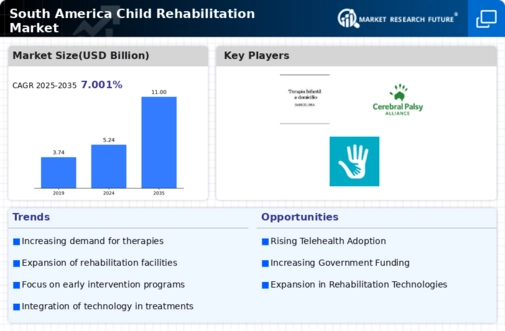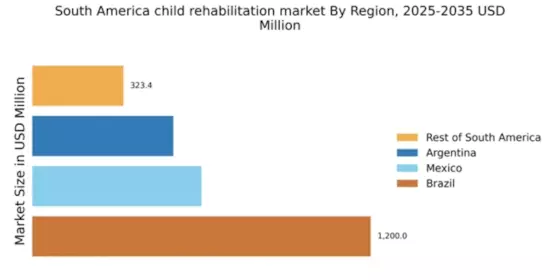Government Policy Reforms
Recent government policy reforms in South America are significantly influencing the child rehabilitation market. These reforms aim to improve access to rehabilitation services for children, particularly in underserved areas. By increasing funding and support for rehabilitation programs, governments are creating an environment conducive to market growth. Policies that promote inclusivity and accessibility are likely to encourage more families to utilize available services. As a result, the child rehabilitation market could see a substantial increase in participation rates, potentially leading to a 15% growth in service demand over the next few years.
Enhanced Awareness and Education
There is a notable increase in awareness regarding child rehabilitation in South America, driven by educational campaigns and advocacy groups. This heightened awareness is crucial as it encourages families to seek rehabilitation services for their children. As more parents understand the importance of early intervention, the demand for rehabilitation services is likely to rise. Educational institutions are also beginning to incorporate information about developmental disorders and rehabilitation into their curricula, further promoting understanding. This trend may lead to a more informed public, which could result in a 20% increase in service utilization within the next few years, thereby positively impacting the child rehabilitation market.
Integration of Multidisciplinary Approaches
The child rehabilitation market is increasingly adopting multidisciplinary approaches, which involve collaboration among various healthcare professionals. This integration is essential for providing comprehensive care to children with complex needs. By combining expertise from fields such as psychology, occupational therapy, and speech therapy, rehabilitation services can be more effective. This trend is likely to enhance treatment outcomes and improve the overall quality of care. As multidisciplinary teams become more common, the child rehabilitation market may experience a growth rate of 25% as families seek out these comprehensive services that address multiple aspects of a child's development.
Rising Incidence of Developmental Disorders
The increasing prevalence of developmental disorders among children in South America is a critical driver for the child rehabilitation market. Reports indicate that approximately 15% of children in the region are diagnosed with conditions such as autism spectrum disorder and attention deficit hyperactivity disorder. This rising incidence necessitates enhanced rehabilitation services, leading to a growing demand for specialized therapies and interventions. As awareness of these disorders expands, parents and caregivers are more likely to seek professional help, thereby propelling the child rehabilitation market forward. The industry is expected to adapt by offering tailored programs that address the unique needs of these children, which could potentially increase market revenues significantly.
Expansion of Private Rehabilitation Facilities
The growth of private rehabilitation facilities in South America is reshaping the child rehabilitation market. These facilities often provide specialized services that cater to the unique needs of children with various disabilities. The private sector's expansion is driven by increasing disposable incomes and a growing middle class, which allows families to invest in quality rehabilitation services. As a result, the market is witnessing a shift towards more personalized and intensive rehabilitation programs. This trend may lead to a competitive landscape where facilities strive to offer innovative therapies, potentially increasing overall market value by 30% over the next five years.


















Leave a Comment